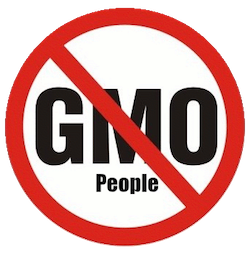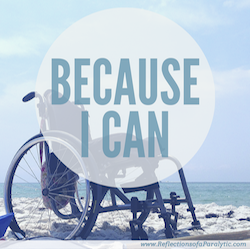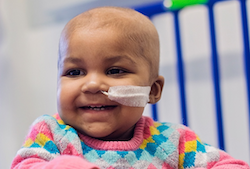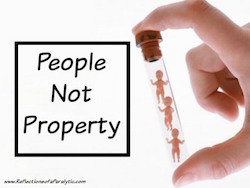BioTalk is finally available on iTunes for your listening convenience.
Please check it out, get caught up on anything you might have missed — and subscribe, so you don’t miss anything in the future!
Subscribe
BioTalk is finally available on iTunes for your listening convenience.
Please check it out, get caught up on anything you might have missed — and subscribe, so you don’t miss anything in the future!
Subscribe

St. Gianna, patron saint of physicians, pray for us!
This morning I was on the Mike Allen Show discussing Canada’s assisted suicide legislation and the real, documented slippery slope of making death acceptable “treatment” for pain and suffering. (I start about 15 minutes in.)
It wasn’t my finest performance, especially toward the end. And as always, we don’t always get to everything we plan to cover.
One of the things I wanted to bring up was the possibility that we could see ourselves in a similar situation as Canada here in the United States — depending on how the current Supreme Court vacancy turns out.
I was not aware that the SCOTUS took up an assisted suicide case in 1997: Washington v. Glucksberg. The justices unanimously rejected the claim that there was a constitutional “right” to assist suicide, but left a sort of open-ended invitation to bring a case in the future.
See: A changing Supreme Court: the legalization of euthanasia could hang in the balance
Despite the movement for physician assisted suicide gaining momentum throughout the country, it still largely continues to be defeated in State legislatures and courts. If pro-euthanasia advocates see an opportunity to bypass the slow and steady approach in the states and take it directly to a suicide-friendly Supreme Court, you can bet they’ll take it.
 In anticipation of Canada passing radical new assisted suicide legislation, my friend Mark Pickup has written a letter to his physician instructing him to never allow or cause him to be euthanized — even if he asks for it:
In anticipation of Canada passing radical new assisted suicide legislation, my friend Mark Pickup has written a letter to his physician instructing him to never allow or cause him to be euthanized — even if he asks for it:
Dear Dr. __:
I can hardly bring myself to write these words but a dark reality in Canada requires it. I am referring to legalizing physician assisted suicide scheduled to begin in 2016. For over 20 years I have feared that a time such as this would come to my country and against the Common Good of society at large. I have spoken across Canada and America against euthanasia and assisted suicide.
Should I ever request assisted suicide, I want you to refuse to help me. On this point I am emphatic. Presume that I am speaking out of depression or that multiple sclerosis has begun to affect my mental state. I would not make such a request in my right mind. If, in your judgment, I am suffering from depression please get me the counseling I need; if the MS is affecting my mind protect me from myself or others who would take my life before my natural death. Regarding my end of life care I ask you to provide treatment in accordance with my Roman Catholic faith (see Catechism of the Catholic Church, Nos 2276-2282) .
I have such deep respect for you and the proper application of your profession (in its Hippocratic tradition) I would not ask you to stop being my healer and become my killer, unless my mental faculties were impaired by depression or disease.
Sincerely,
Mark Davis Pickup
I don’t blame Mark for being so cautious.
Once upon a time physicians and medical professionals — believers and non-believers alike — actually swore an oath to recognize and uphold the dignity of their patients and “never do harm” or administer deadly medicine to anyone — even when asked. Not anymore.
And once we start making death an acceptable “treatment” for pain and suffering, we are in for a world of trouble.
Here Mark discusses the new assisted suicide legislation and its potential impact on society and the medical profession.
The “slippery slope” of assisted suicide is real and well documented. One only has to look at places like Belgium and the Netherlands, where euthanasia has been legal for several years.
In fact, Dr. Theo de Boer, a professor of health care ethics at the Theological University in Kampen and associate professor of ethics at the Protestant Theological University in Groningen in the Netherlands, recently penned a warning to other countries considering the practice.
Writing in the American Protestant magazine Christian Century, Dr. de Boer, a former member of a euthanasia review board in the Netherlands, notes how he saw the pace of euthanasia accelerate, rising by 15 percent each year. And how, as the numbers climbed, the criteria expanded.
It is a must-read for anyone interested in the assisted suicide/euthanasia debate.
More good news from Europe: last month the Council of Europe’s Social Affairs and Health Committee voted against the draft report on surrogacy that proposed regulation of the practice rather than a full ban.
This comes just three months after the European Parliament approved a resolution condemning all forms of surrogacy as “reproductive exploitation and use of the human body for financial or other gain”.
No doubt Europe is under heavy pressure to allow surrogacy as the “Global Rent-A Womb Industry is Beginning to Crumble“.
Due to ethical concerns of exploitation, countries like Cambodia, India, Mexico, Thailand and others have restricted the practice by closing their doors to foreign and same-sex couples.
Unfortunately, without even so much as a whisper of a national conversation on the practice, America seems content to remain the “Wild West” of third party reproduction.
I spoke with Mike Allen a little bit about this on his radio show recently:
I know many people who consider third party reproduction (3PR) a “gift from God” to suffering infertile couples. But as far as I can see, 3PR is and has been, more than anything I’ve seen in modern history, a prime example of human beings “playing God.”
The latest example comes from American model Chrissy Teigen and her Grammy winning husband, John Legend who are expecting a baby girl — and not by accident.
“I’ve made this decision,” Teigen told People. “Not only am I having a girl, but I picked the girl from her little embryo. I picked her and was like, ‘Let’s put in the girl.'”

In his book Three to Get Married, Ven. Fulton Sheen I recently came across this:
Our entire outlook on life, conception and birth changes once these things are seen not as an evolution from slime, but as a gift from the Divine. Human generation is not a push upward from the beast, but rather a gift downward from the Trinity. The begetting of children is not an imitation of the beasts of the field, but a feeble reflection of the eternal generation of the second Person in the bosom of the Father.
It’s amazing how much “our entire outlook on life, conception and birth” has changed in such a short time.
Contrast the good bishop’s words to those of Dr. Gil Wilshire with Mid-Missouri Reproductive Medicine and Surgery in Columbia, MO, who said: “We need three things: a good egg, some good sperm and a good uterus. And we can mix and match these.”
This is the world we live in. The creation of new human life is nothing more than a biological formula; a science experiment, rather than the mysterious fruit of a loving act between husband and wife; a gift of science rather than a gift from the Divine.
Is it any wonder, then, that people think they can pick and choose from the children they manufacture which ones get to see the light of day?
Taking the creation of life out of its natural, God-given context and moving it into the science lab has seriously altered how many view the wonder and mystery of new life and how that new life should be treated.
Sex-selection is not uncommon with 3PR, especially here in the United States, and “weeding out” weak, diseased or otherwise “defective” embryos is standard practice. As gene editing technology progresses, is there any doubt we’ll “designer babies” in the not-to-distant future?
Recommended: Chrissy Teigen’s ‘embryo-shopping’ is a slap in the face
Last year the restaurant chain Chipotle made major headlines for announcing that all(ish) of its food would be “GMO free” (that’s fine, I never liked Chipotle, anyway). They actually received a heavy amount of criticism for this move, nevertheless, it’s safe to say they wouldn’t have done it if there weren’t a growing number of the general public wary of the “health risks” of so-called “Frankenfoods.”
 For a society that cares so much about genetically-modified organisms in their food supply, you would think we’d be a little more cautious about the genetic modification of people.
For a society that cares so much about genetically-modified organisms in their food supply, you would think we’d be a little more cautious about the genetic modification of people.
After nearly a year of evaluation, last month the National Institutes of Medicine recommended that the FDA approve three-parent embryo techniques for use in IVF in the United States.
In this episode of BioTalk, I spoke with Dr. David Prentice about what, if anything, is being done to stem the tide of human genetic engineering in the United States. And if there’s any hope for tighter, more permanent restrictions in the future.
Audio only:
If the embedding does not work for either of those, click here for: YouTube — Soundcloud.
We’ve all read and shared the stories: a basketball coach “lets” the disabled team manager dress out and participate in the final seconds of the last game of the season, a senior with Down syndrome is elected prom queen, etc… I’ve even been known to share a few, myself, but lately they’ve been making me increasingly uncomfortable — not the situations, themselves, but the media’s reporting on them.
On the air with Mike Allen this week we talked about one specific example of “inspiration porn” that I personally identified with and what I thought was wrong not just with the media hype, but also with that particular situation. Click the play button below to listen:
 This article, however, does a great job articulating what is wrong with the media’s reporting on these situations in general.
This article, however, does a great job articulating what is wrong with the media’s reporting on these situations in general.
Pornography, whatever your feelings about it, is inherently aimed at the viewer. That’s the whole point. Inspiration porn, likewise, turns the disabled individual into an object for your consumption. These stories place the emphasis on the typical person who does something nice to the disabled person, assuming that’s who you will identify with. The non-disabled person gets to be active; they get to drive the narrative forward. We learn about why they did their good deed and how it all makes them feel. Such pieces often editorialize, or allow wise grownups to editorialize, about how good these young people are.
In contrast, the disabled individuals are rendered passive. They rarely get to speak for themselves, to communicate how they feel, or to express their desires. Their lack of competence is presumed.
I used to see these stories as showing the world a positive side to life with a disability, but the reality is that they often do very little to humanize the individuals with disabilities or raise awareness around real issues or experiences. In fact, although frequently well-intentioned, they really only perpetuate the “otherness” of people with disabilities and focus instead on “someone else’s emotional high”.
At its core, inspiration porn — specifically the kind that focuses on an able-bodied person “helping” someone with a disability — “demonstrates the need for a broader engagement with the social model of disability.” As I have said here before, often the hardest part about living with a disability is not coming to terms with what I can’t do, but dealing with the perception that I am more helpless than I really am.
I’m not saying there’s anything wrong with being inspired or wanting to inspire others. We should all want to inspire each other to be better people everyday. But, as David M. Perry notes, the disability community “needs much more than kind restaurant employees, handsome quarterbacks and photo shoots. We need better policy, changing norms and real conversations about key issues. Inspiration porn makes us feel that everything is going to be OK. That’s possible only if we stop being distracted by pretty stories and have the tough conversations.”
Related:
Because I Can
Since scientists in China confirmed last year that they have been editing the genomes of several non-viable human embryos from IVF clinics using a new promising gene-editing technique called CRISPR, most of the discussion about gene editing technology has centered around altering human embryos to eradicate certain diseases.
It sounds like a great idea, but there are some serious ethical concerns.
First, this kind of germ-line modification genetically alters future generations without their consent — and there is no telling what kind of effect this will have. Then, of course, there is the fact that many, many embryos and fetuses will have to be sacrificed on the alter of science to finally make it a reality.
There is also the likely possibility that it won’t long be limited to merely treating genetic defects, but upgrade to enhancing otherwise healthy embryos, which, as Rebecca and I talked about in the last episode of BioTalk, is a “biological arms race” that no one can win.
It should be noted, however, that altering embryos is not the only way gene editing technology can or should be used.
In the last episode of BioTalk Rebecca also encouraged the ethical use of gene editing technology like CRISPR in patients living with diseases today.
 One-year-old Layla is a beautiful example of gene editing technology put to good, ethical use.
One-year-old Layla is a beautiful example of gene editing technology put to good, ethical use.
Layla’s leukemia — that doctors were almost certain she would shortly die from — is currently in remission thanks to gene-editing technology that allowed her to receive modified immune cells from another person.
“Her leukemia was so aggressive that such a response is almost a miracle,” said Paul Veys, a professor and director of bone marrow transplant at Britain’s Great Ormond Street Hospital (GOSH) who led the team treating Layla.
According to Nature, her case is the second trial of gene-editing as a therapy. It was first used to treat 12 people with HIV.
The therapy that Layla received takes immune cells from a healthy donor and exposes them to a type of DNA-cutting enzyme called a TALEN.
The enzyme deactivates immune genes that would otherwise cause the donor cells to attack when injected into a person with leukaemia, and modifies genes to protect the new cells from anti-cancer drugs that the patient is taking.
The individual then undergoes therapy to destroy his or her own immune system, which is replaced with the modified cells. The treatment is not a permanent solution for leukaemia patients, says Qasim, but rather a ’bridge‘ to keep the person alive until a matched T cell donor can be found.
In the HIV patients, researchers used a different class of DNA-cutting enzyme called a zinc-finger nuclease (ZFN).
When added to blood extracted from the patients, the ZFNs cut the gene for a protein on T-cells targeted by HIV, and the team then pumped the cells back into the patients.
The results were positive and more than 70 patients have now been treated with the therapy.
More of this, please!
Gene editing is not unethical in and of itself. Using these gene-editing techniques on patients in a non-germ-line fashion is a much better approach. This gives each generation the opportunity to not only benefit from new advances, but also give consent.
 Last year the UK became the first in the world to offer controversial ‘three-parent’ fertility treatments. This year they approved the use of CRISPR to edit genomes of human embryos.
Last year the UK became the first in the world to offer controversial ‘three-parent’ fertility treatments. This year they approved the use of CRISPR to edit genomes of human embryos.
In the latest episode of BioTalk, Rebecca Taylor and I talk about how scientists and governments have re-engineered language to sell the public on embryo-re-engineering.
We also look at the long-term implications of genetic enhancement. Specifically, how enhancement leads to coercion and the loss of human dignity.
Audio only:
If the embedding does not work for either of those, click here for: YouTube — Soundcloud.
Recommended: We Need a Moratorium on Genetically Modifying Humans — Paul Knoepfler, a professor at the University of California, Davis, School of Medicine, is by no means “pro-life”, but he understands the serious consequences of germ-line genetic modification.
He has also spoken on the coercive nature of genetic enhancement.
Embryo custody battles are on the rise. Except, legally speaking, they aren’t really “custody” battles — in the traditional sense of the term. They’re more like property disputes.
 I was very pleased recently to find out that Missouri Right to Life has gotten together with a few other pro-life organizations to file an amicus brief in the case of McQueen v. Gadberry in Missouri Court of Appeals.
I was very pleased recently to find out that Missouri Right to Life has gotten together with a few other pro-life organizations to file an amicus brief in the case of McQueen v. Gadberry in Missouri Court of Appeals.
The pro-life groups are working on behalf of Jalesia McQueen, who wants to implant and give birth to the remaining two embryos that she and her ex-husband made while they were still married. She is appealing a Trial Court ruling, which ordered that the embryos must stay frozen unless and until both parties can agree on what to do with them. They also ruled that the embryonic children are marital property — though of a “unique type,” because what one party does with them in the future (the mother) may impose unwanted obligations on the other (the father).
In the latest episode of BioTalk, I spoke with my good friend Jim Cole, who is the General Cousel for Missouri Right to Life and who was responsible for editing much of the brief.
I also spoke with Mike Allen about it on his show last week:
You can read the entire brief here, and I highly suggest you do if you have time (I’ve never read a legal brief before — it’s not as difficult as I thought it would be).
The constant theme throughout is what is in the best interest of the (embryonic) children involved. And that is the ironic legacy of IVF: that couples are so desperate for children to love and yet concern what’s good and right for the children themselves is actually put last.
The Trial Court ruled against Jalesia McQueen obtaining and implanting her own embryos citing her ex-husband’s “right not to procreate.” Which is, of course, ludicrous, since procreation has already taken place.
Science establishes — and Missouri Law agrees — that a human being begins at fertilization. “Once procreation has occurred and human life has begun,” the brief states, “the rights and interests at issue can no longer be framed solely as the procreative or reproductive interests of the parents.”
America has a sordid history of defining certain classes of human beings as property. Let’s not go down that road again.